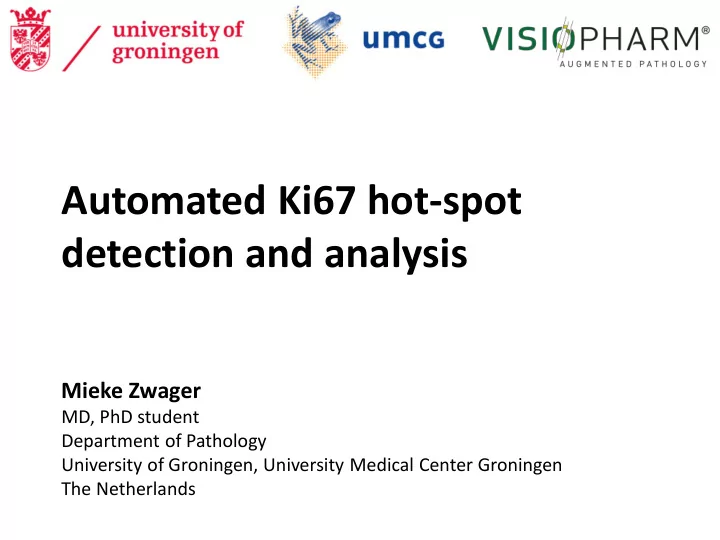

Automated Ki67 hot-spot detection and analysis Mieke Zwager MD, PhD student Department of Pathology University of Groningen, University Medical Center Groningen The Netherlands
Background Ki67 • Nuclear protein • Expressed during cell cycle • Prognostic and predictive in breast cancer G1 M G0 S G2 Ki67 low Ki67 high
Background Standardised manual Ki67 hot-spot scoring • Select one high-power field with highest staining rate • Count up to 500 cells • Type-writer pattern • Median scoring time: 6 minutes (4-8) S.C.Y. Leung et al. Analytical validation of a standardised scoring protocol for Ki67 immunohistochemistry on breast cancer excision whole sections: an international multicentre collaboration. Histopathology 2019: 75;225-235.
Background Hot-spot scoring • Visual identification is difficult • Labour-intensive • Inter- and intra-observer variability • Inter-observer reproducibility/ICC of 0.8 S.C.Y. Leung et al. Analytical validationof a standardised scoring protocol for Ki67 immunohistochemistry on breast cancer excision whole sections: an international multicentre collaboration. Histopathology 2019: 75;225-235.
Background & Objective Digital image analysis • Automated detection and scoring • Standardised and reproducible Objective • Compare manual Ki67 hot-spot scoring and detection with digital image analysis (DIA) Koopman T. et al. Digital image analysis of Ki67 proliferation index in breast cancer using virtual dual staining on whole tissue sections: clinical validation and inter-platform agreement. Breast Cancer Res Treat. 2018; 169:33-42.
Methods 102 breast carcinomas Manual hot-spot detection and scoring
Methods DIA manual hot-spot Manual hot-spot detection and scoring Automated hot-spot detection and scoring
Automated hot-spot selection and analysis 2. DCIS vs. 6. Ki67 1. Tumor 3. Ki67 4. Heat map 5. Hot spot invasive tumor quantification identification identification quantification creation discrimination within hot spot VirtualDoubleStaining™
Manual Ki67 hot-spot correlation is suboptimal R² = 0,78 90 80 70 60 Manual Scores Observer 2 50 40 30 20 10 0 0 10 20 30 40 50 60 70 80 90 100 Manual Scores Observer 1
Manual and DIA scores of the manual ROIs strongly correlate R² = 0,90 100 90 80 70 60 Image Analysis 50 40 30 20 10 0 0 10 20 30 40 50 60 70 80 90 100 Manual Scores
Automated Ki67 hot-spot analysis leads to higher proliferation indices Mean Ki67 hot-spot score 45 40 35 30 25 Mean Ki67 hot-spot 20 score 15 10 5 0 Observer 1 Observer 2 DIA
Conclusion Automated Ki67 hot-spot detection and analysis is a reliable method that leads to higher hot-spot Ki67 proliferation indices
Acknowledgments UMCG/UG • Dr. Bert van der Vegt • Dr. Timco Koopman • Henk Buikema Visiopharm • Dr. Henrik Klingberg • Dzenita Omanovic • Dr. Andreas Schønau
Recommend
More recommend